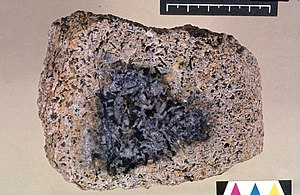Bauxite fibrosis
| Bauxite fibrosis | |
|---|---|
| Other names | Shaver's disease, Corundum smelter's lung, Bauxite lung or Bauxite smelters' disease |
 | |
| Bauxite with unweathered rock core | |
| Specialty | Pulmonology |
Bauxite pneumoconiosis, is a progressive form of pneumoconiosis usually caused by occupational exposure to bauxite fumes which contain aluminium and silica particulates.[1]
It is typically seen in workers involved in the smelting of bauxite to produce corundum.[2]
Presentation[]
Initially, the disease appears as alveolitis, and then progresses to emphysema.[3]
Patients may develop pneumothorax (collapsed lung).
Diagnosis[]
This section is empty. You can help by . (September 2017) |
There is no way to be diagnosed rather than chest x Ray's and lung function test and a history of a sick person
Treatment[]
This section is empty. You can help by . (September 2017) |
References[]
- ^ Tamotsu Takishima (1994-05-23). Basic and Clinical Aspects of Pulmonary Fibrosis. CRC Press. pp. 391–. ISBN 978-0-8493-8927-6.
- ^ WYATT JP, RIDDELL AC (1949). "The morphology of bauxite-fume pneumoconiosis". Am. J. Pathol. 25 (3): 447–65. PMC 1942907. PMID 18127135.
- ^ Lippincott (2012-11-05). Professional Guide to Diseases. Lippincott Williams & Wilkins. pp. 1200–. ISBN 978-1-4511-7892-0.
External links[]
| Classification |
|---|
Categories:
- Lung diseases due to external agents
- Respiratory disease stubs